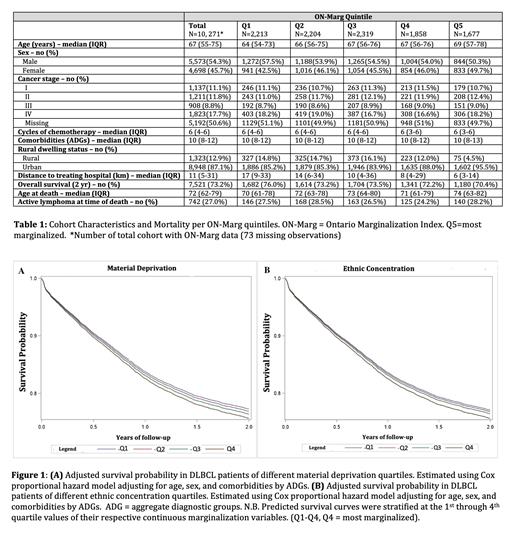Abstract
Introduction: While health disparities in diffuse large B-cell lymphoma (DLBCL) have been previously noted, literature systematically describing the impact of social determinants of health (SDOH) on DLBCL overall survival (OS) is sparse. Furthermore, existing data largely examine SDOH of health in isolation, not accounting for key covariates or disease-related variables. Marginalization, which accounts for various SDOH, is a process of systemic discrimination and exclusion. Given the paucity of literature to date, we examined how marginalization influences DLBCL OS in the Canadian setting. The objectives of this study were: 1) To describe the impact of marginalization on DLBCL OS and 2) To identify which dimensions of marginalization, if any, impacted OS.
Methods: We conducted a population-based retrospective cohort study of adult patients with newly diagnosed DLBCL in Ontario between January 1, 2005 to December 31, 2017 receiving a rituximab-containing chemotherapy regimen for curative intent, followed until March 1, 2020. Our primary exposure of interest was the Ontario Marginalization Index (ON-Marg), an administrative database tool which combines demographic indicators into four distinct marginalization dimensions: residential instability (% renters and % living alone), material deprivation (% low income and % lone parent families), dependency (% seniors and % employment), and ethnic concentration (% recent immigrants and % visible minority). Our primary outcome was 2-year OS, defined as time from the date of first rituximab-based treatment to date of death or completion of follow-up. Survival curves were generated using Kaplan-Meier methods, and Cox regression analyses were used to identify covariates that were independently associated with OS. Our final model adjusted for age (as increments of 10 years), sex, and comorbidity burden as measured by aggregate diagnostic groups (ADGs).
Results: A total of 10,344 patients were diagnosed with DLBCL and treated with a rituximab-containing regimen in Ontario between January 1, 2005 and December 31, 2017. The median age was 67 (IQR, 55-75) and 46% were female. Of patients who had staging data (49%), 54% were advanced stage at diagnosis, and the median number of cycles of chemoimmunotherapy received was 6 (4-6). Median number of ADGs was 10 (8-12), indicating a moderate-to-high burden of comorbidities within this cohort, and 13% of patients resided in a rural area. Cohort characteristics and mortality rates per ON-Marg quintile (Q5 = most marginalized) are provided in Table 1. Overall, group characteristics were evenly distributed, except that the most marginalized group had a higher proportion of patients residing in urban settings and nearer to treatment hospitals. Two-year overall survival was 73.2%. After controlling for relevant confounders, material deprivation (hazard ratio [HR] 1.06, 95% confidence interval [CI] 1.02 - 1.10, p=0.003) and ethnic concentration (HR 1.05, 95% CI 1.01 - 1.09, p=0.013) contributed to increased risk of all-cause mortality. Residential instability and dependency had no significant effect. Increasing age (HR 1.29, 95% CI 1.25 - 1.33, p<0.0001) and increasing number of ADGs (HR 1.028, 95% CI 1.025 - 1.031, p<0.0001) were also associated with increased risk of all-cause mortality, while female sex was found to be protective (HR 0.89, 95% CI 0.83 - 0.97, p=0.005).
Discussion: To our knowledge, no study has examined the impact of marginalization and collective SDOH on DLBCL outcomes. We found that increased material deprivation and ethnic concentration conferred increased mortality. While Canada's largely single-payer system and previously documented healthy immigrant effect may have been expected to attenuate effects of income and immigration, our study suggests otherwise. Possible explanations may include barriers to healthcare access for patient subsets, who may have less support for treatment. Structural factors such as systemic racism, health literacy, and caregiver burden must also be taken into account. These factors require further evaluation to inform targeted interventions and establish support for increased access to timely care amongst this patient population.
No relevant conflicts of interest to declare.


This feature is available to Subscribers Only
Sign In or Create an Account Close Modal